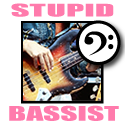|
Cheap Shot posted:That's what I personally use but we tried it and it just wasn't the right tool for the job. I think maybe one that isn't as directional might work better but the problem comes from the sound coming out of two ends going at right angles to the mic in the middle. It was coming in unclear and distant. That's why I assumed double mic'ing would be the solution but I have no idea honestly. What are the hangups with double miking? Poor results for what I want it for in specific, or just general difficulty? If you use a spaced pair to separately capture each end of the instrument, you'll get a wonky, hyper-wide stereo image, which will be exacerbated by the inherent movement of the billows. In headphones, it'll sound like the instrument is flying in circles around your head. If you sum them to mono, you'll end up with a hollow, flangey, jet engine sound. Both scenarios are dumb if you're trying to capture the essence of a traditional acoustic instrument. When you get a little distance between the mic and the instrument, then both the bass and the treble side will balance themselves in the room, and you can use either a single microphone or a "coincident pair", which is not prone to the problems mentioned above. Remember that as an audience member, you don't need to stick your ear next to each side of the concertina to enjoy the sound, so why should you do that with your mics? Here's a fairly decent sounding concertina on Youtube, which was miked with a coincident stereo pair from the player's feet: https://www.youtube.com/watch?v=oqcosJHAepA The bass and treble side sound pretty balanced to me, and it didn't require spaced microphones. If you're recording in a small and/or untreated room, there may not be an acceptable "sweet spot" for a mic. Too close will sound buzzy and hissy and clicky, and too far will sound like the crappy spare bedroom it's in, and in-between is a horrible combination of the two. So step one is to relocate (or run cables) to the biggest room in the house, and get the instrument as far away from any walls as possible, though not quite in the dead center of the room. Build a nook of couch cushions and heavy blankets a few feet around the player, and find a way to hang a blanket above him, to absorb reflections from the ceiling. Remember that reflections are generally your sworn enemy in all but the most magnificent of of locations. Now have him play for a few minutes, and plug one ear with your finger while you hover your head around the space like an idiot and listen for where the most balanced sound seems to come together. It might be two feet away or maybe ten. It might be a foot off the floor or perhaps over his shoulder or behind him. Just take your time and actually listen as you slowly move about until you hear something special. Whichever spot sounds best to your ear will probably sound best through a microphone. Now what type of microphone should you use? I've had good experiences with ribbon mics on reed instruments, as their gentle roll-off helps mellow out some of the uglies. Also, since most of them are a figure-8 pattern, it's easy to position them to attenuate early reflections from the floor and/or ceiling while aimed direcly at the source. If you want it in stereo, get two ribbons and set them up in the "Blumlein" configuration. It's one of the most seamless, mono-compatible and natural sounding stereo setups, as long as you keep any sources out of the "side" quadrants. Another nice setup for figure-8's is the "Faulkner Array", which generally works best at more of a distance. It can help to hang a couple of blankets a few feet behind the mic(s), if the room is in a really poor state. Superlux, Avantone, Cascade and Shinybox all make great ribbons at fairly affordable prices. Now that you're all set up, record a test pass and have a listen, making sure that you've panned your stereo pair (if applicable) to opposite channels. If it's too screechy and grating, the mics are probably too close to the instrument. If it's too boxy and dull, they're probably too far. If it's lopsided in one of the channels, then the mic pair needs to be rotated to compensate. If there's a big hump or hole in the spectrum, you've probably got a big old exposed surface reflection that needs to be blocked with more absorptive material. If you're getting a lot of rumble, then wait till the dishwasher cycle is done and try again. The key is to listen analytically to what you're capturing, and spend some time figuring out what it is that you do or don't like about the sound. If incremental changes of the mic position don't help, try big changes. Try having the player sit in a different part of the room. Take notes as you go, and label each test recording with whatever changes were made to the physical setup. If nothing sounds amazing and you're ready to give up, then go back and listen through all of your test takes and decide which one sounded the least lovely, because this is probably the best you're going to get in that room with that instrument. Since you took such great notes, it should be easy to re-create that setup and start recording for real.
|
|
|
|

|
| # ? May 17, 2024 15:23 |
|
snappo posted:If you use a spaced pair to separately capture each end of the instrument, you'll get a wonky, hyper-wide stereo image, which will be exacerbated by the inherent movement of the billows. In headphones, it'll sound like the instrument is flying in circles around your head. If you sum them to mono, you'll end up with a hollow, flangey, jet engine sound. Both scenarios are dumb if you're trying to capture the essence of a traditional acoustic instrument. When you get a little distance between the mic and the instrument, then both the bass and the treble side will balance themselves in the room, and you can use either a single microphone or a "coincident pair", which is not prone to the problems mentioned above. Remember that as an audience member, you don't need to stick your ear next to each side of the concertina to enjoy the sound, so why should you do that with your mics? Thank you, I'll see if we can figure this out. I appreciate all the info! I'm a little worried that ribbon mics are outside the buget though. Do you have any back up suggestions if they aren't an option? Money is tight. Hoping to spend 100$ or less. Don't need studio quality.
|
|
|
|
I'm not aware of any ribbon mics under $200, so that may be out. The next best thing will probably be a multi-pattern condenser, like a Behringer C-3 or Nady SCM-1000, or something along those lines. Do you have an interface that provides phantom power? If not, that's another bit of $$$ that will need to be spent in order to get any sound at all out of a condenser. If you do go that route, you're opening up a lot of options. Each polar pattern on switchable mics tends to have a different frequency response, which you can use to make up for deficiencies in the source--omni is brighter, fig-8 is darker, cardioid tends to be in-between. As I mentioned in my last post, figure-8 can do wonders for cancelling floor and ceiling reflections that would otherwise mess with the timbre of your signal... don't listen to people who say you need a great room in order to get any benefit from that pattern.
|
|
|
|
snappo posted:I'm not aware of any ribbon mics under $200, so that may be out. The next best thing will probably be a multi-pattern condenser, like a Behringer C-3 or Nady SCM-1000, or something along those lines. Do you have an interface that provides phantom power? If not, that's another bit of $$$ that will need to be spent in order to get any sound at all out of a condenser. Nady makes a ton of sub-$200 ribbon mics. I have the RSM-2 and it sounds great. E: Just noticed the budget is $100, Nady makes the RSM-5 (which is on sale at MF for $60) if ribbon is what you really really want. Never heard what it sounds like, but it seems to be well reviewed. himajinga fucked around with this message at 20:12 on Jan 22, 2013 |
|
|
|
The Cascade FatHead BE (Bare Essentials edition, which means you don't get a case or a fancy shockmount - just a regular clip - but the mic is the exact same as the pricier model with the same guts) is only $129 right now with the stock transformer (side note: I'LL TAKE EIGHT!  ) )Lovely mics and very much worth considering in that price range! You can also upgrade the transformer to a Lundahl but the price goes up considerably. strangemusic fucked around with this message at 22:39 on Jan 22, 2013 |
|
|
|
HERE IS A DUMB QUESTION: I bought a cheap pair of 150 watt JBL monitors I want to use with my MobilePre. The MobilePre has 1/4" line outputs, and the monitors have those spring clip stereo connectors:  I'm pretty sure the signal coming from the line outputs is amplified, right? So that shouldn't be a problem? But what's the best way to interface these two dudes?
|
|
|
|
stuart scott irl posted:HERE IS A DUMB QUESTION: Sorry duder, line out is line level and is not going to power those. you need an external amp for those. Something like this http://www.sweetwater.com/store/detail/SLA1?utm_source=Google&utm_medium=PPC&utm_campaign=none&gclid=CKTYoezJ_bQCFQLd4AodvT0AYQ Coincidentally I have that exact amp sitting around that I might part with. Hollis Brownsound fucked around with this message at 04:58 on Jan 23, 2013 |
|
|
|
ah nutsack Well thanks
|
|
|
|
This isn't really a question about home recording per se but rather of my whole setup at home. I've got a Nord keyboard, a midi keyboard, a synth and electric guitars I like to record. I've also got a Focusrite Scarlett 2i2 that I use with my Mac (and Ableton Live). Up until now I've only played my synth and keyboard with headphones and I'm now looking for monitors. I asked in another thread how I should best set up this stuff without having to plug and unplug stuff all the time. It seems there are two preferred options: 1) plug everything into an audio interface, which is then connected to the computer and monitors, or 2) plug everything* into a mixer which then goes into my Scarlett 2i2 and so on. Since I've already got an audio interface I think I should just look for a cheap, used mixer. Smart? If I go for this option, would it be a problem to use my Nord's stereo output? However, I won't use this setup just for recording. In fact, most of the time I'm just playing for the fun of it. This includes connecting my computer to my Nord keyboard and jam along to other songs (or learn new stuff off of Youtube). How should I set this up? Can my Focusrite play the sounds from my computer (via the USB) and stuff from my keyboard simultaneously? Or would I need to connect the computer directly into my Nord keyboard first? It might not seem like a bit deal, but it kind of is because I also have to set this up in a smart way physically. * midi keyboard would go directly into the computer
|
|
|
|
Xabi posted:This isn't really a question about home recording per se but rather of my whole setup at home. A couple of things: - It sounds like the Nord keyboard can connect via USB and act as its own sort of "interface", yes? That is, it transmits sound as well as MIDI over the USB connection? If so, you should be able to set up an aggregate device (in the Mac's Audio/MIDI Setup tool) to bundle the Nord and the Focusite together, so you could use the Nord's virtual inputs and the Focusrite's front panel inputs simultaneously (as separate tracks in Ableton Live), and output everything to monitors connected to the Focusrite's outputs. - A simple external mixer would be a good way to get more inputs into your Focusrite, though obviously everything would be mixed down to one stereo pair coming into the interface. The other thing to be aware of is that since you mentioned guitars, the Scarlett can use its inputs as high impedance instrument inputs, which are better for guitar/bass. If you go looking for a mixer, it'd be preferable to use one with built in instrument inputs (often also called hi-Z), or else run the guitar through a DI (direct input) box. Running a guitar through a mixer channel without hi-Z inputs will still technically work, but the signal will be weaker and you'd lose some high end. Another thing you could probably do is use one Scarlett input for guitar, one for a synth (in mono), plus you'd still have your Nord keyboard and softsynths.
|
|
|
|
h_double posted:A couple of things: h_double posted:- A simple external mixer would be a good way to get more inputs into your Focusrite, though obviously everything would be mixed down to one stereo pair coming into the interface. The other thing to be aware of is that since you mentioned guitars, the Scarlett can use its inputs as high impedance instrument inputs, which are better for guitar/bass. If you go looking for a mixer, it'd be preferable to use one with built in instrument inputs (often also called hi-Z), or else run the guitar through a DI (direct input) box. Running a guitar through a mixer channel without hi-Z inputs will still technically work, but the signal will be weaker and you'd lose some high end. e: There's no real reason for my to plug the guitar into the mixer anyway, cos I could just plug it into the Focusrite whenever I'm recording guitar parts. Most of the time I'm just jamming along after all. h_double posted:Another thing you could probably do is use one Scarlett input for guitar, one for a synth (in mono), plus you'd still have your Nord keyboard and softsynths. Xabi fucked around with this message at 12:45 on Feb 5, 2013 |
|
|
|
Xabi posted:I'm not planning on plugging the guitar directly into the mixer (or even the Focusrite). I'm using a mic in front of my amp. Do I still need a hi-Z mixer? Nope, you only need to worry about hi-Z inputs if you are plugging the instrument directly into the board. It sounds like a basic 8-12 channel would be a pretty good fit for your setup. There's usually tons of used Mackie mixers on ebay/Craigslist, or Tascam or Yamaha. I'd avoid Behringer, the quality isn't the greatest.
|
|
|
|
Thanks, very much appreciated!
|
|
|
|
Didn't see a better thread to ask this in... I just got a mic stand and a "universal" mic clamp. It works fine on my SM57 but I have an AKG Perception 100 mic as well, which is a pretty chubby condenser mic. What kind of clamp do I need for that? I searched and can't find anything that looks big enough. Would http://www.amazon.com/Samson-SP01-Shockmount-Spider-Condenser/dp/B000LQLDM2 work? Is there anything cheaper? edit: I was looking for a "shock mount" ashgromnies fucked around with this message at 04:45 on Feb 9, 2013 |
|
|
|
Has anyone had any success getting good sound out of speakers connected to a Line6 POD? I'd like to pick something up that will reproduce what I hear in the headphones? I'd like to use the POD as all-but-the-speaker now, rather than just a preamp, but I need something to actually make noise, and for that, I need a speaker to hook it up to.
|
|
|
|
MC Fruit Stripe posted:Has anyone had any success getting good sound out of speakers connected to a Line6 POD? I'd like to pick something up that will reproduce what I hear in the headphones? I'd like to use the POD as all-but-the-speaker now, rather than just a preamp, but I need something to actually make noise, and for that, I need a speaker to hook it up to. It sounds great through a studio set-up (mixer-poweramp-monitors), and very good through a regular oldfashioned stereo set-up (amp-decent speakers). As long as the A.I.R. is engaged of course. This is for clean sounds though - overdriven/distorted presets could sound a bit thin depending on what you're looking for. e: if you just want a single speaker set-up: I've found it sounds good through a large bass speaker driven by any old powereamp Underflow fucked around with this message at 14:06 on Feb 9, 2013 |
|
|
|
I'm looking for critiques and advice on my mixing. I have a post in the "getting-poo poo-to-sound-good thread", but that thread seems to have died down compared to this one. I am recording in Ableton Live 8 through a Scarlett 2i2. 2 guitar tracks and 1 bass track are all done through Guitar Rig 4 (bass track is really just a guitar with GR4 settings made to sound more like a bass guitar). Drums are EZ Drummer. Guitar tracks are panned at 33L and 33R. Here is the first https://soundcloud.com/argonrock/jade-and-the-void This first one sounded very flat. I added Focusrite's EQ to each individual track to get a better sound. I'm really getting stuck trying to find the optimal mix to get a more full sound. When I compare it to a dummy track (usually Russian Circles or Pelican in this case) I just can't get the track to be loud enough without clipping while also having as full of a sound as I want. Here is the second https://soundcloud.com/argonrock/jade-and-the-void-with-eq This is what I came up with after playing around with it, and although it sounds much better it's still not right. Any input is appreciated! (little note: I'm heading out for a day trip so I won't be able to respond until at least tonight.) edit: I just added a new mix where in which I added several of Live's built in vst's such as the limiter, multiband dynamics, utility, eq eight, and the spectrum analyzer. I think it definitely has a fuller sound, however it's still very quiet when compared to professionally produced songs. https://soundcloud.com/argonrock/jade-and-the-void-with-ableton Still looking for any critiques! Fiendish Dr. Wu fucked around with this message at 17:55 on Feb 11, 2013 |
|
|
|
ashgromnies posted:Didn't see a better thread to ask this in... http://www.bhphotovideo.com/c/product/811165-REG/AKG_1040_Z_00020_SH_100_Shockmount.html
|
|
|
|
I do some basic recording -- mostly vocals and acoustic guitar. Right now, I record with a condenser mic into a Behringer 802 mixer. From there, I connect the board to my computer with a dual 1/4" to a 1/8". I'm just using the interface built in to my motherboard. I have no idea if this makes any practical sense. My decision on how to connect things was based almost entirely on "what cords will fit". It sounds pretty OK to me. So I've got some questions. 1. Am I doing anything really stupid in this setup? 2. I want to record using my laptop so I can put everything in my closet to reduce ambient noise. My MacBook Pro only has one audio interface, though -- it can either be used for input or output. It's a huge pain in the dick to configure it for input, plug the mixer in, record, then unplug the mixer, plug the headphones in, configure it for output, then check the quality and volume. And then there's the problem of recording tracks on top of each other. I want to be able to hear my click track or the instrumental track I recorded while I record vocals or another instrumental track. How do I fix this? In looking at firewire and USB audio interfaces, I'm not sure what exactly they do and how that will affect the quality of the input and output. From what I understand they perform the a/d conversion, and this conversion will affect the quality of both input and output signals. So will I degrade my recording and playback with a cheap one? 3. How do I want to configure my mixer and computer for the best quality and least amount of noise? I've got the four controls: preamp gain, channel level, main mix level, and then my computer's input level. I'm not sure how to set up those settings to minimize noise while still getting a usable volume.
|
|
|
|
dakana posted:I do some basic recording -- mostly vocals and acoustic guitar. If I'm not mistaken, I have that same mixer: I drove to bumfuck Oregon to record my Mom and my aunt singing backup vocals, and brought everything but my mixer and so had to buy something in-town. Your biggest problem so far is your interface on your Mac. You need something that has at least one output and one input, because you want a click track and all the relevant source material you've gathered so far (I'm amazed that you don't have that most basic capacity to be honest). Since you are recording one source at a time, latency is not a factor: the mixer is your zero-latency monitor for the track-being-recorded, and everything else's latency is the same, because it's all on playback to the same cue. You need some sort of gadget that increases the amount of ins/outs on your Apple computer. Someone here will recommend something to you; I don't have that info, sorry. For recording anything, in general what you want to do is to get your basic RMS (the average level) on your mixer to read unity (0 db). You can have some transients (plosives, some plectrum-on-guitar sounds, &c.) peaking at +6 dB, however, in general, the sweet spot of most mixing boards (and cheap Behringer boards especially) is 0dB. Ignore completely any readings on your DAW for now. For the most part they're full of poo poo. When tracking (recording) what is most important is the total signal the mixing board is sending to the interface on your computer (this isn't entirely true but for your purposes, it is). Keep in mind that for all of these recordings, you're going to go the DAW after recording and trimming a bunch of tracks way, way, wayyyyyy down. That isn't what concerns you now however. What you want now is to get the best-sounding individual tracks, one at a time. Once they are digital, it more or less doesn't matter how much you turn them up or turn them down, because doing so isn't doing anything to the noise floor that you haven't already done, because ones and zeroes digital poo poo. So record each track perfectly and hold your head high
|
|
|
|
So I've been practicing on my Micro Korg for like 6 months now and I'm feeling ready to start recording stuff. What would I need to record the korg on my mac? I bought some M-Audio thing the idiot at guitar center recommended and all it does is let me use the korg as a midi controller. So I don't feel like going back there and rather ask you knowledgeable folks. Thanks in advance.
|
|
|
|
KidDynamite posted:So I've been practicing on my Micro Korg for like 6 months now and I'm feeling ready to start recording stuff. What would I need to record the korg on my mac? I bought some M-Audio thing the idiot at guitar center recommended and all it does is let me use the korg as a midi controller. So I don't feel like going back there and rather ask you knowledgeable folks. Thanks in advance. What is the M-Audio thing the idiot sold you? That could help determine your needs.
|
|
|
|
himajinga posted:What is the M-Audio thing the idiot sold you? That could help determine your needs. This thing. http://www.m-audio.com/products/en_us/Uno.html
|
|
|
|
Oh yeah, that guy was an idiot. You'll need an actual audio interface if you want to record the audio output of your keyboard. Does your Mac have firewire ports? What is your budget? That'll help determine a good interface recommendation. This guy seems to be getting a lot of love recently and is USB. If you want to screw around and get the feel for recording without dropping cash on recording software just yet, Garageband is definitely serviceable.
|
|
|
|
dakana posted:I do some basic recording -- mostly vocals and acoustic guitar. If you are going to be adding an interface anyway (which is a good idea), you would probably want to take the Behringer mixer out of the setup altogether and just record directly into the interface. A decent interface will likely have better mic preamps than the Behringer, and you'd be eliminating the noise of the mixer circuitry. There is a audio interface thread you might want to look at; these days the most popular recommendations in the $150-200 range are the Focusrite (Scarlett) and Tascam interfaces. So then, you would plug you mic(s) into the preamps on the interface and set the preamp gain (input level) so that the signal peaks are fairly close to 0 but never actually go into the red (you never want to go over 0 with digital recording, this is called clipping and sounds very noticeably lovely). The amount of gain will depend on the type of mic, what it is you're recording, etc. but it's not rocket science -- just do a couple of test recordings, look at the waveforms and use your ears.
|
|
|
|
himajinga posted:Oh yeah, that guy was an idiot. You'll need an actual audio interface if you want to record the audio output of your keyboard. Does your Mac have firewire ports? What is your budget? That'll help determine a good interface recommendation. This guy seems to be getting a lot of love recently and is USB. If you want to screw around and get the feel for recording without dropping cash on recording software just yet, Garageband is definitely serviceable. I'm on a macbook air so I'm limited to 2 USBs and a thunderbolt. I will check that out what cables does it require? I don't recognize the ports on the back of it.
|
|
|
|
KidDynamite posted:I'm on a macbook air so I'm limited to 2 USBs and a thunderbolt. I will check that out what cables does it require? I don't recognize the ports on the back of it. That big squareish plug on the back is just a USB 2.0 port, sometimes printers and audio stuff come with that type of plug, I assume it comes with the cable you need, the end that plugs into the computer will be a normal thin USB 2.0 end just like anything else. The inputs are combo XLR/1/4" jacks, so you can just plug the outputs from the MicroKorg into the middle hole of the two inputs for stereo recording, or just into the first one for mono.
|
|
|
|
Looking for some more critique / advice on my mix. Here is the most recent mix: https://soundcloud.com/argonrock/jade-and-the-void-with I'm still trying to find the best mix maintaining loudness and clarity. It's definitely getting better but it still has some ways to go. I have the last 3 mixes still up as well for comparison (1)(2)(3) Also question: How important is it to look at the sound levels in a program like Audacity? Previous mix is top, new mix is bottom:  In the new mix it's clipped off at the top because of the limiter, which completely kills any clipping, and it sounds better to my untrained ear, but is it okay like that? I can see the right channel is slightly louder than the left, but it's just the fact that it's either 100% SOUND ON or off that I'm unsure about.
|
|
|
|
Fiendish Dr. Wu posted:Looking for some more critique / advice on my mix. I mean....... Yeah you don't want anything clipping and limiting it is better than stuff clipping but...... You just mangled any dynamics you ever had. Everything just sounds flat, loud but flat. Edit: You also mix like a guitar player, the guitars are way too loud. Your kick and snare sound be the loudest 2 sounds in your mix, I think that's why it sounds so flat. Your guitars are hitting the limiter, not your drums. Hollis Brownsound fucked around with this message at 14:33 on Feb 12, 2013 |
|
|
|
HollisBrown posted:I mean....... Yeah you don't want anything clipping and limiting it is better than stuff clipping but...... You just mangled any dynamics you ever had. Everything just sounds flat, loud but flat. How can I manage to turn up the overall sound without losing the dynamics? As far as I understand, that's what a compressor is for - I guess I just really don't know how to set it properly. When I compare it to professionally done mixes its either quiet and dynamic or louder and flat. Are you saying that the kick and snare should be the loudest two sounds in the mix? And that they are the things that should be hitting the limiter?
|
|
|
|
I'm looking for a - I'm not sure of the term, maybe a softsynth or a vst instrument? I'm trying to find software to work with Cubase that will give me the sound of all those vintage keyboards: arps, moogs, mellotrons, all that cool stuff from those old Return To Forever and Genesis records. It doesn't have to be free, but anything more than a couple hundred bucks would be fairly prohibitive. I did look a bit, and I see that IK Multimedia has Samplemoog, but I'd like to see what else is out there. Any recommendations? Or alternatively, is there a more appropriate thread to ask this kind of thing?
|
|
|
|
Fiendish Dr. Wu posted:How can I manage to turn up the overall sound without losing the dynamics? As far as I understand, that's what a compressor is for - I guess I just really don't know how to set it properly. When I compare it to professionally done mixes its either quiet and dynamic or louder and flat. You're going to lose dynamics no matter what you do, but I think what you have going on the mix is that your guitar is the loudest thing and is constantly slamming against the limiter and triggering reduction constantly, if you set your levels so the limiter is triggered by either the kick or snare, you'll give your limiter time to release. And yes I meant "the kick and snare should be the loudest sounds in your mix".
|
|
|
|
Seventh Arrow posted:I'm looking for a - I'm not sure of the term, maybe a softsynth or a vst instrument? I'm trying to find software to work with Cubase that will give me the sound of all those vintage keyboards: arps, moogs, mellotrons, all that cool stuff from those old Return To Forever and Genesis records. It doesn't have to be free, but anything more than a couple hundred bucks would be fairly prohibitive. I did look a bit, and I see that IK Multimedia has Samplemoog, but I'd like to see what else is out there. Any recommendations? Or alternatively, is there a more appropriate thread to ask this kind of thing? Something like this for Kontakt looks like it might work: http://www.native-instruments.com/#/en/products/producer/powered-by-kontakt/retro-machines-mk2/ Kontakt Player is free so I'm pretty sure you can just buy that for $69 and use it.
|
|
|
|
ashgromnies posted:Something like this for Kontakt looks like it might work: http://www.native-instruments.com/#/en/products/producer/powered-by-kontakt/retro-machines-mk2/ Hey that does look pretty cool. Thanks, I'll check it out.
|
|
|
|
HollisBrown posted:You're going to lose dynamics no matter what you do, but I think what you have going on the mix is that your guitar is the loudest thing and is constantly slamming against the limiter and triggering reduction constantly, if you set your levels so the limiter is triggered by either the kick or snare, you'll give your limiter time to release. And yes I meant "the kick and snare should be the loudest sounds in your mix". Thanks, this is just the kind of input I was looking for
|
|
|
|
There's a lot of digital/plugin talk in the thread, but does anyone use reel-to-reel tape in a home mastering situation? I'm going to pick up a cheap deck locally for a test then bring back a Technics RS-1500 from Japan while I'm on holiday. I am curious to see how others use it.. personally I am looking at taking either a live recording from a desk straight to tape and dub to cassette, or a digital master to tape then dub to cassette.
|
|
|
|
I made another mix based, focusing on clarity and dynamics, and I think it's really starting to sound better. https://soundcloud.com/argonrock/jade-and-the-void-with-1 Basically I... - increased high and mid freq's on the two guitar tracks, lowered low freq - increased low freq on bass, lowered high - increased low freq on drums, changed the mic setup, changed compression (few ms slower release) - turned the limiter up to 0db and increased the gain slightly - tried to balance the sounds better I have a question about this:  It's looking much better than my previous attempts, but I'm mostly curious about the spikes around :30 to 1:15 and 1:50 to 2:20. What is best for reducing those spikes? With the limiter engaged, there is no clipping, and there is plenty of headroom in the master channel, but I'm really not sure what's up with those spikes. Thanks in advance.
|
|
|
|
niff posted:There's a lot of digital/plugin talk in the thread, but does anyone use reel-to-reel tape in a home mastering situation? I'm going to pick up a cheap deck locally for a test then bring back a Technics RS-1500 from Japan while I'm on holiday. I am curious to see how others use it.. personally I am looking at taking either a live recording from a desk straight to tape and dub to cassette, or a digital master to tape then dub to cassette. just one won of these fuckers for cheap. (M version) http://www.thevintageknob.org/sony-TC-D5.html
|
|
|
|
So I think I'm going to upgrade to Pro Tools 10 today. I resisted going from 8 to 9 but now I feel like I should just bite the bullet and do it. Has anyone else done it? Is it really better than 8?
|
|
|
|

|
| # ? May 17, 2024 15:23 |
|
HollisBrown posted:So I think I'm going to upgrade to Pro Tools 10 today. I resisted going from 8 to 9 but now I feel like I should just bite the bullet and do it. Has anyone else done it? Is it really better than 8? It's a step up from 8 - if you were going from 9 to 10 I would be less positive, but as it is you should have nothing to fear.
|
|
|
























